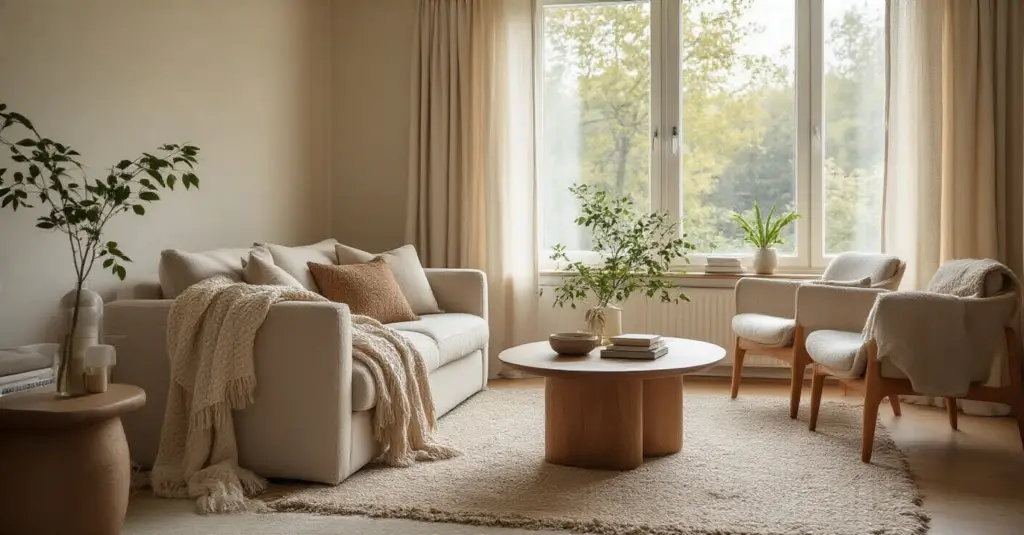Can we talk about the biggest mistake people make with their living rooms? It drives me nuts. Everyone thinks “cozy” just means throwing a few chunky-knit blankets on a couch and lighting a pumpkin spice candle. And sure, that’s part of it. But it’s surface level. True coziness, the kind that makes people feel instantly relaxed and want to hang out for hours, isn’t an accident. It’s engineered. It’s a deliberate blend of psychology, interior design, and—yes—the right tech.
A truly great entertainment space is one that feels warm and inviting before you even sit down. It’s a room that encourages conversation, makes the movie experience more immersive, and just makes people feel good. Forget the corporate speak about “curating experiences.” Let’s talk about what actually works. I’ve seen clients spend a fortune on gear and furniture, only to have a room that feels cold and sterile. Then I’ve seen others, on a tiny budget, create a space that’s the magnetic center of their home. Here’s the real story, the shortcuts I wish I’d known earlier, and the BS to ignore.
Foundations for Lasting Warmth and Comfort (Part 1)
Alright, so before you even think about buying a single pillow, we need to lay the groundwork. This is the stuff that everyone skips because it’s not as fun as shopping, but it’s the difference between a room that looks cozy on Instagram and one that actually feels cozy when you’re in it with your friends. This is all about understanding the room itself—its light, its flow, and its hidden flaws.
1. Assess Your Room’s Natural Light and Layout for Optimal Placement
You know what people always ask me? “Where should the TV go?” And my answer is always, “First, tell me where the sun goes.” Before you plan anything, spend a day just watching the light move through your room. Where’s that perfect, sunny afternoon spot? That’s your reading chair zone. Where’s the corner that stays darker and moodier? That’s your prime spot for a lamp-lit conversation nook. Don’t fight the room’s natural energy—use it.
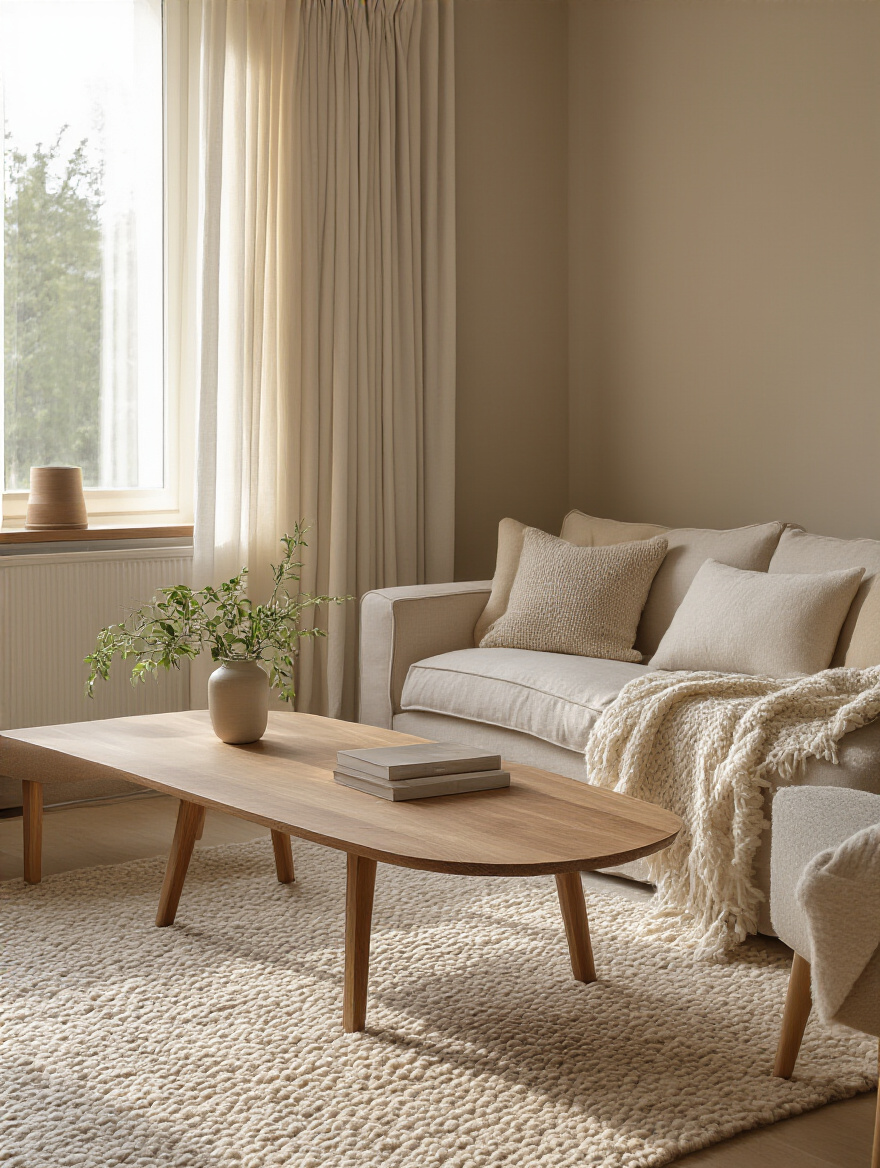
This isn’t just about vibes; it’s about function. Glare is the enemy of a good movie or game session. So placing your main screen opposite a huge, bright window is just asking for frustration. Sketch out the room, mark the windows and the outlets, and map out the natural pathways people will take. You want to create comfortable little islands of activity that feel intentional, not like a furniture obstacle course.
This initial mapping is the single most important step for getting your layout right from the start.
2. Define Your Coziness Aesthetic: Choose a Color Palette and Style That Radiates Warmth
Everyone says to “pick colors you love,” and that’s just bad advice. I mean, you can love neon green, but painting your living room with it won’t exactly scream “cozy.” The real story is that warmth is a feeling we can create with color. Think earthy tones: terracotta, deep forest greens, mustardy yellows, rich browns, creamy whites. These colors absorb light differently and trick our brains into feeling warmer and more secure.
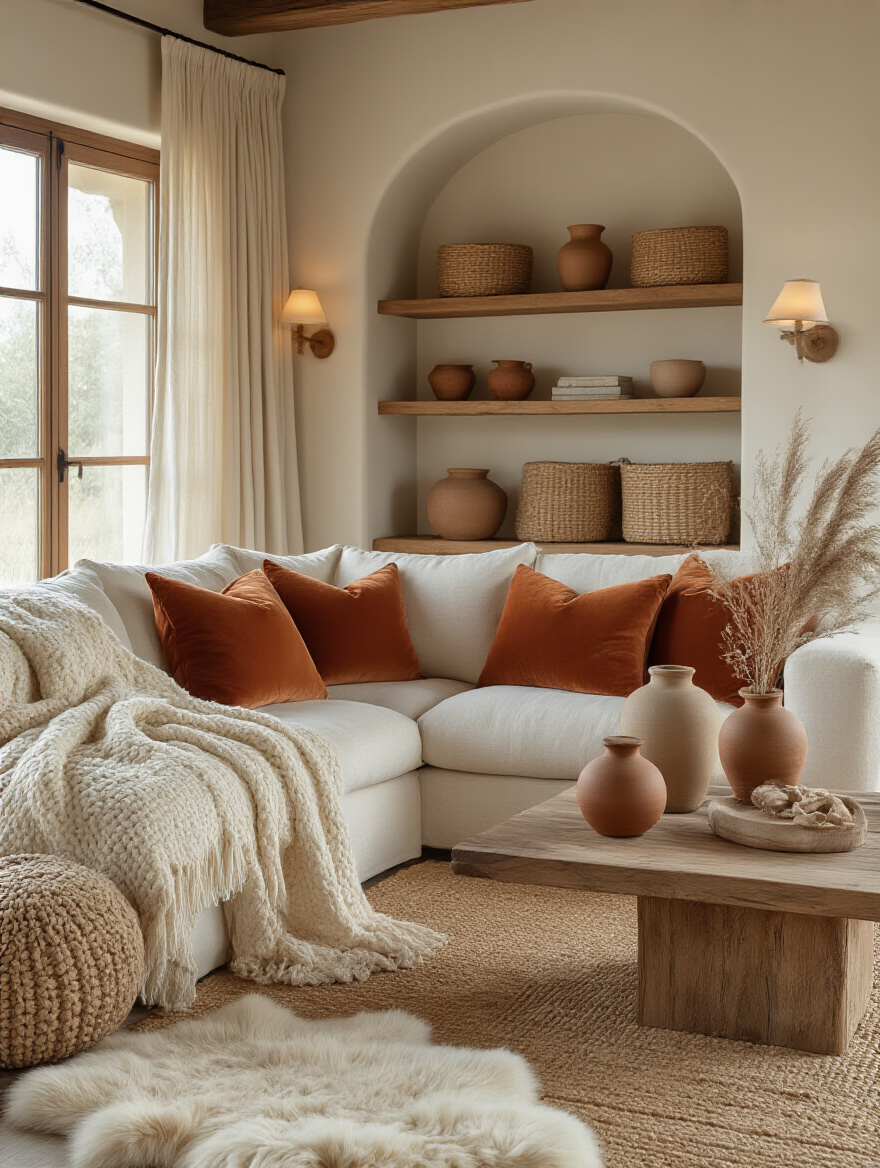
Your mission here is to create a mood board. No, seriously. Go on Pinterest or just rip pages out of a magazine. Figure out if you’re going for “modern cabin,” “bohemian lounge,” or “classic library.” This North Star will guide every single choice you make, from the paint to the pillows. It stops you from buying that one random thing that looks cool in the store but clashes with everything else and kills the cohesive, warm vibe you’re trying to build.
Getting this right prevents your room from feeling like a chaotic collection of stuff.
3. Map Out Zones for Relaxation: Plan Seating Arrangements for Intimate Conversations or Quiet Reading
My biggest pet peeve? When I walk into a living room and all the furniture is shoved up against the walls like it’s at a middle school dance. It’s a total vibe killer! You’re creating this dead space in the middle of the room that no one wants to cross. Instead, think of your living room as a collection of destinations. You need to create zones. The main zone is your conversation pit—a sofa and a couple of armchairs pulled together, close enough that people can actually talk without yelling.

Then, you create a secondary zone. Maybe it’s that single comfy chair and an ottoman in the corner for someone who wants to chill out with a book or their phone. You define these zones with things like area rugs and specific lighting. An area rug under your main seating group acts like a giant “gather here” sign. A single floor lamp over an armchair says “this is a solo spot.” This is how you make a room work for two people or twenty.
This small shift in thinking transforms your room from a static showroom into a dynamic social space.
4. Evaluate Current Insulation & Drafts: Pinpoint Areas Losing Heat for Targeted Improvement
Okay, let’s get a little technical but trust me, this matters more than any throw blanket you can buy. A room that’s genuinely cozy is one that’s not secretly bleeding heat. You can have the plushest couch in the world, but if there’s a sneaky draft coming from the window, nobody’s going to feel comfortable. This is the unsexy part that pays off big time, both in comfort and on your energy bill.
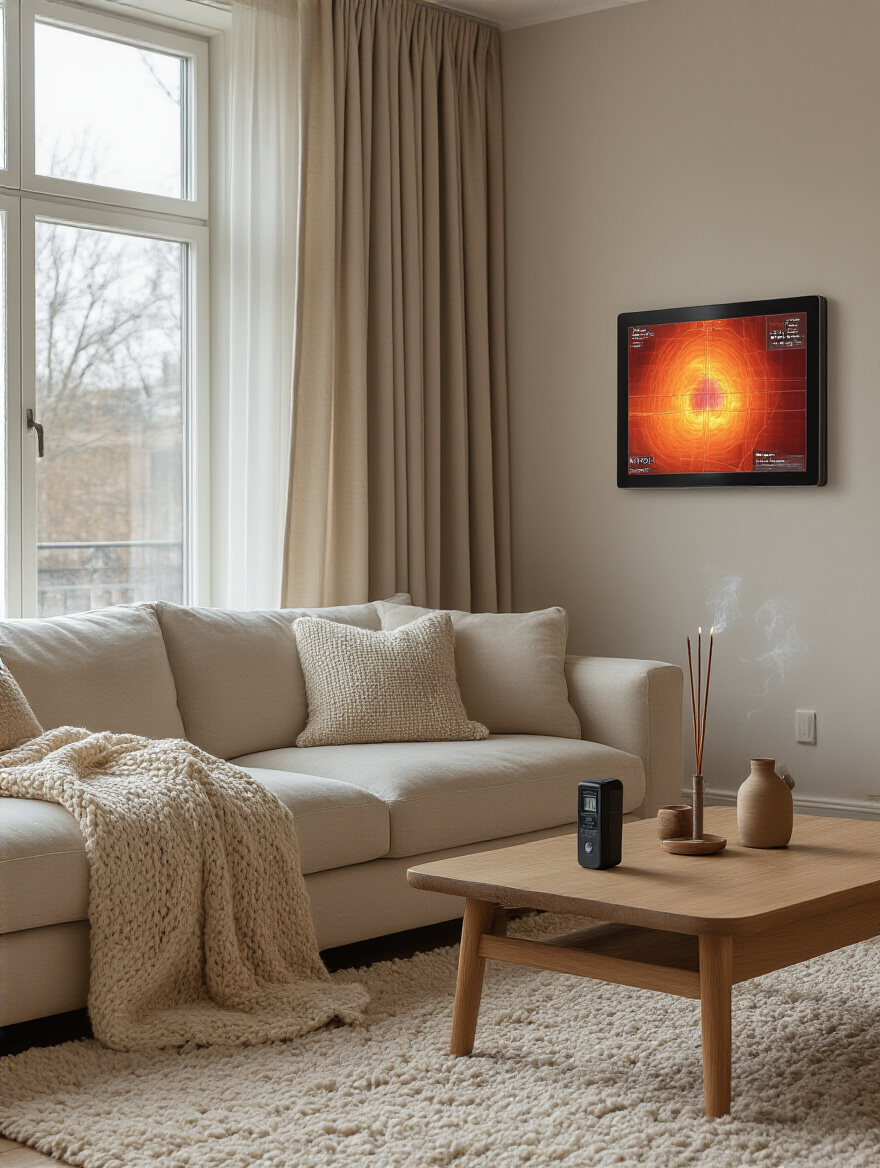
Here’s the shortcut I wish I knew: the incense trick. On a cool, windy day, light a stick of incense and hold it near the edges of your windows, doors, and even electrical outlets. If you see the smoke waver or get sucked away, congratulations—you’ve found a draft. Sealing those little gaps with some cheap caulk or weatherstripping is a ridiculously effective upgrade. It’s like putting a warm hat on your house, and it makes every other effort to create warmth ten times more effective.
Fixing these invisible leaks is the foundation for genuine, lasting physical warmth.
Foundations for Lasting Warmth and Comfort (Part 2)
So you’ve analyzed the space and plugged the leaks. Awesome. Now comes the part where vision meets reality: the budget. I know, I know, nobody likes talking about money, but this step is your secret weapon for creating a high-impact space without the stress of overspending. A smart plan here means you can get the cozy, warm haven you want without a financial hangover.
5. Set a Realistic Budget for Comfort Enhancements to Guide Your Transformation
Here’s where everyone messes up: they start buying things without a plan. They see a cool lamp here, a neat pillow there, and by the end, they’ve spent a ton of money on small stuff and don’t have enough left for the big-ticket item that would have made the real difference, like a great rug. A budget isn’t a leash; it’s a battle plan. It forces you to decide what actually matters.
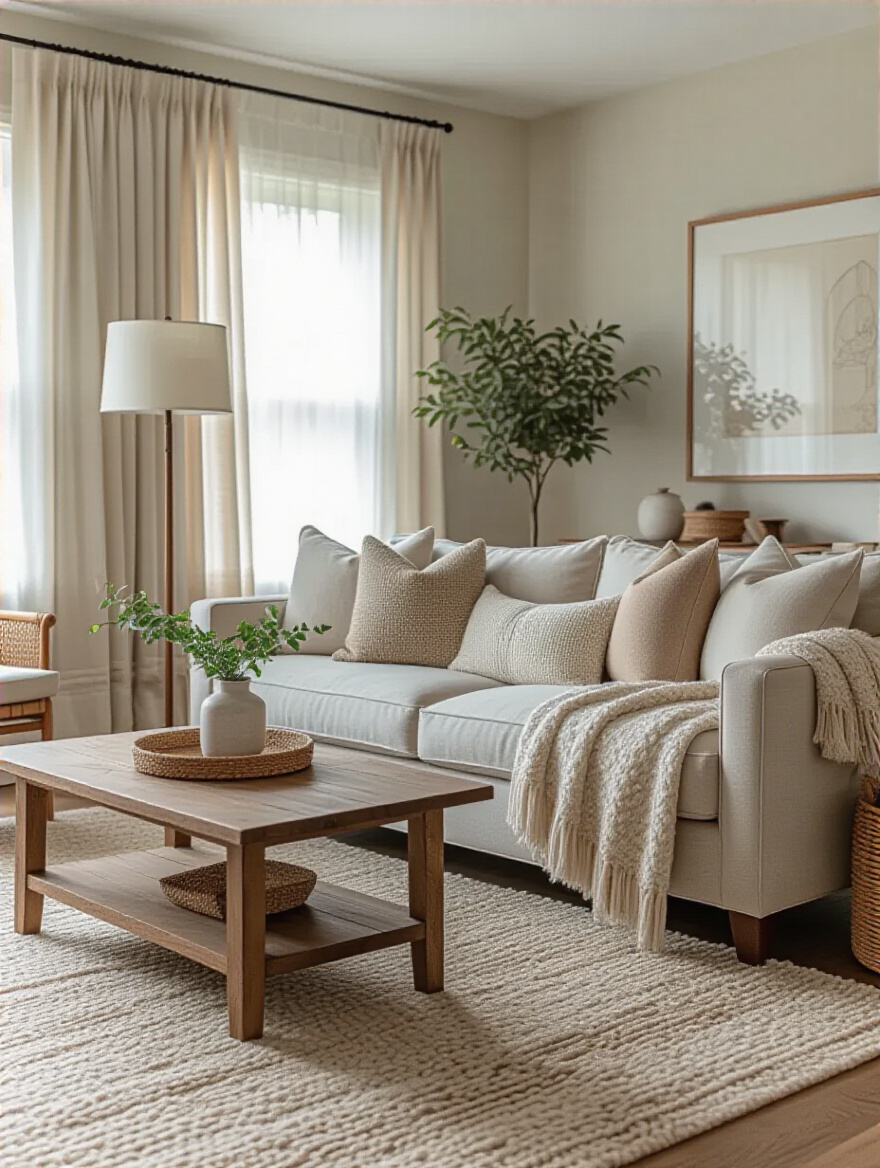
Make a list of what you want, then divide it into “Must-Haves” and “Nice-to-Haves.” Your must-haves are the high-impact items: layered lighting, a comfortable rug, a killer throw. Then, price them out. Look at a few different stores to get a real sense of cost. And whatever your total is, add 15% for the “oops” fund—shipping, taxes, that one thing you forgot. This strategic approach ensures you spend your money where it will deliver the biggest cozy-for-your-buck.
A clear budget is what turns your wishlist into a reality without the financial headache.
Implementing Core Elements for Physical Warmth (Part 1)
Now we’re getting to the fun stuff—the core ingredients that deliver that tangible feeling of warmth and comfort. This is where we start building the sensory experience of the room. We’re talking about the things you can see and touch that immediately tell your brain, “This is a place to relax.” These are the foundational layers that will support all the other styling choices we make later.
6. Select a Plush, High-Pile Area Rug to Instantly Add Softness, Sound Dampening, and Floor Insulation
A bare floor in a living room is a crime against coziness. An area rug isn’t just decoration; it’s a functional powerhouse. A plush, high-pile rug does three critical things: First, it provides a layer of insulation from a cold floor, which makes a shocking difference in how warm a room feels. Second, it absorbs sound, cutting down on echo and making conversation feel more intimate and clear. It’s a subtle audio upgrade that most people don’t even realize they’re benefiting from.
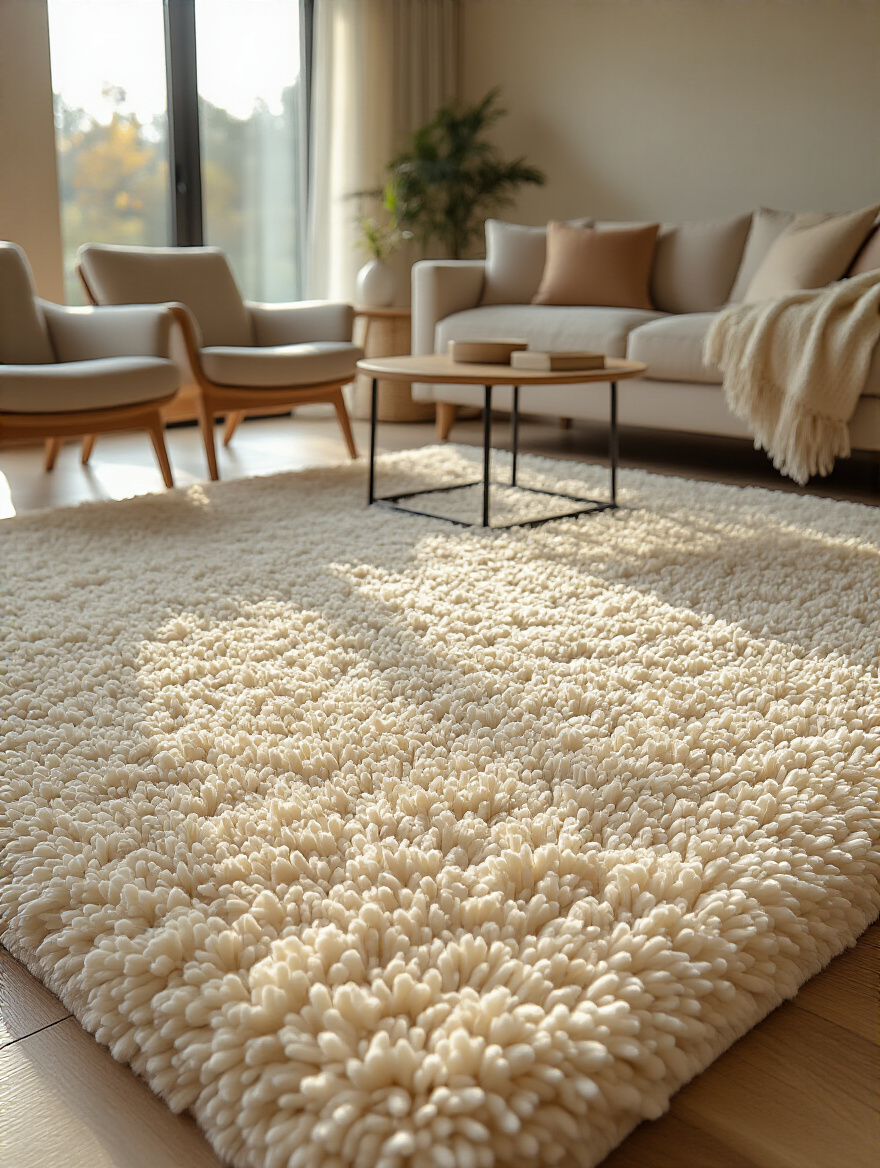
Third, and most obviously, it feels amazing underfoot. That softness immediately sends a signal of comfort to your brain. Here’s the key: don’t cheap out and get one that’s too small. The front legs of all your main furniture should be on the rug. This visually anchors your conversation zone and makes the space feel bigger and more cohesive. It’s the single fastest way to add a massive dose of warmth and softness to a room.
This is your first and most important step in building tactile comfort from the ground up.
7. Install Insulated Drapes or Thermal Blinds to Prevent Heat Escape Through Windows
Windows are just giant holes in your wall that leak heat. You can have your furnace blasting, but if your windows are bare, you’re basically trying to heat the great outdoors. Insulated drapes or thermal blinds are like putting a winter coat on your windows. They have a special backing that creates an air barrier, trapping warm air in during the winter. It’s an incredibly effective way to stop drafts and make the whole room feel warmer.
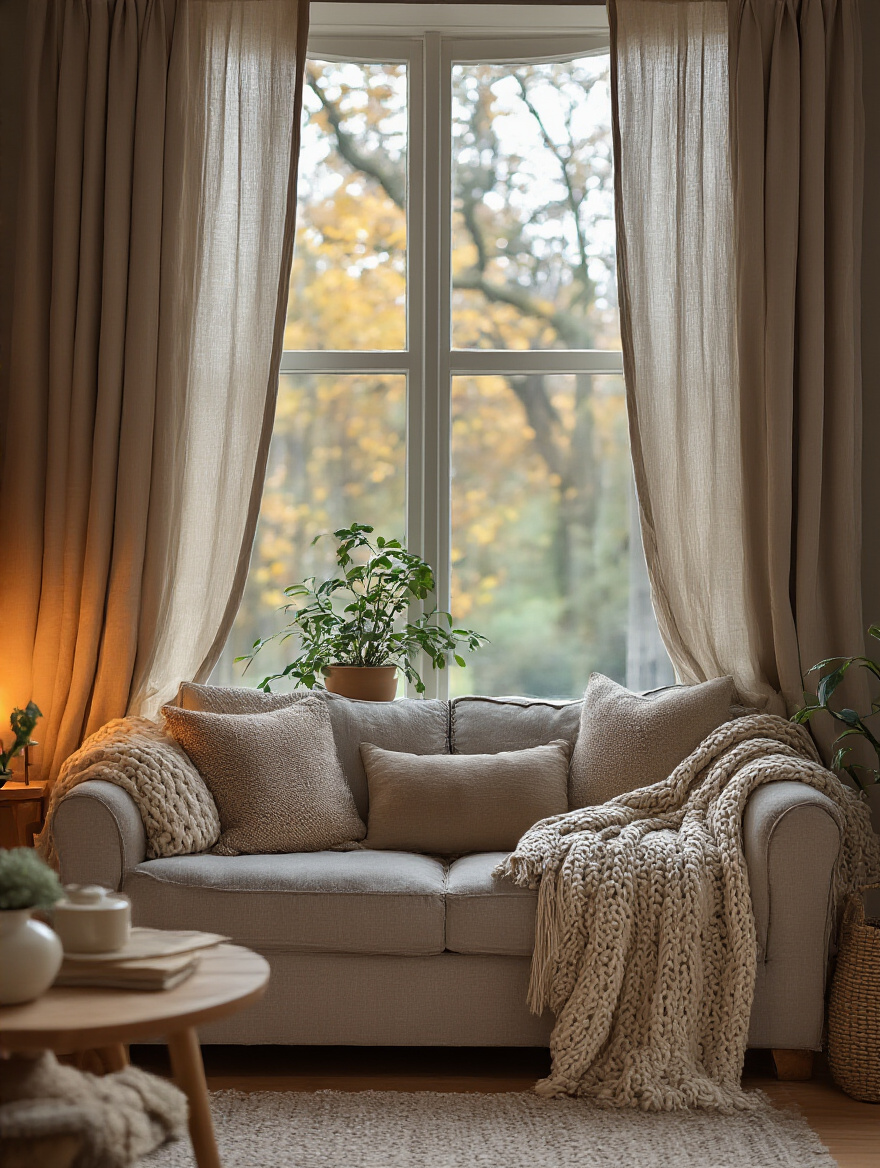
The secret to making them work is in the installation. Mount the curtain rod so it’s wider and higher than the window frame. This allows the drapes to completely cover the window and frame when closed, creating a much better seal. When you can, layer them. Put thermal cellular shades (the honeycomb-looking ones) against the glass and then hang insulated drapes over them. It’s a one-two punch against heat loss and makes a massive difference in comfort.
Dressing your windows isn’t just for looks; it’s a critical part of your room’s thermal defense system.
8. Incorporate Soft, Deep-Seated Furniture Designed for Sinking-In Comfort and Relaxation
You want a living room that encourages lounging, right? Where people put their feet up and settle in for hours? Then you need furniture that’s built for it. I’m talking about deep-seated sofas and armchairs. Forget those stiff, upright pieces that look good in a catalog but are terrible to actually sit on. You want something with a seat depth of at least 24 inches, something you can curl up in.

The goal is to create a physical “embrace.” When you sink into a plush, deep couch, your body relaxes on a primal level. It signals safety and comfort. Look for cushions made from high-resilience foam wrapped in down or a down-alternative. That gives you the supportive “sink” without having your couch turn into a lumpy mess after six months. This is an investment, but it’s the heart of your cozy setup.
The right furniture doesn’t just fill a space; it actively invites people to relax and stay awhile.
9. Choose Warm-Toned Paint or Wallpaper to Visually Enhance the Room’s Thermal Perception
Color is a total mind-hack. Painting your walls a cool, sterile gray or stark white can make a room feel degrees colder than it actually is. By choosing warm tones—those earthy reds, oranges, yellows, or even a creamy beige with a warm undertone—you’re doing a bit of visual trickery. Our brains associate these colors with fire and sunlight, and it genuinely makes us perceive the space as warmer and more inviting.
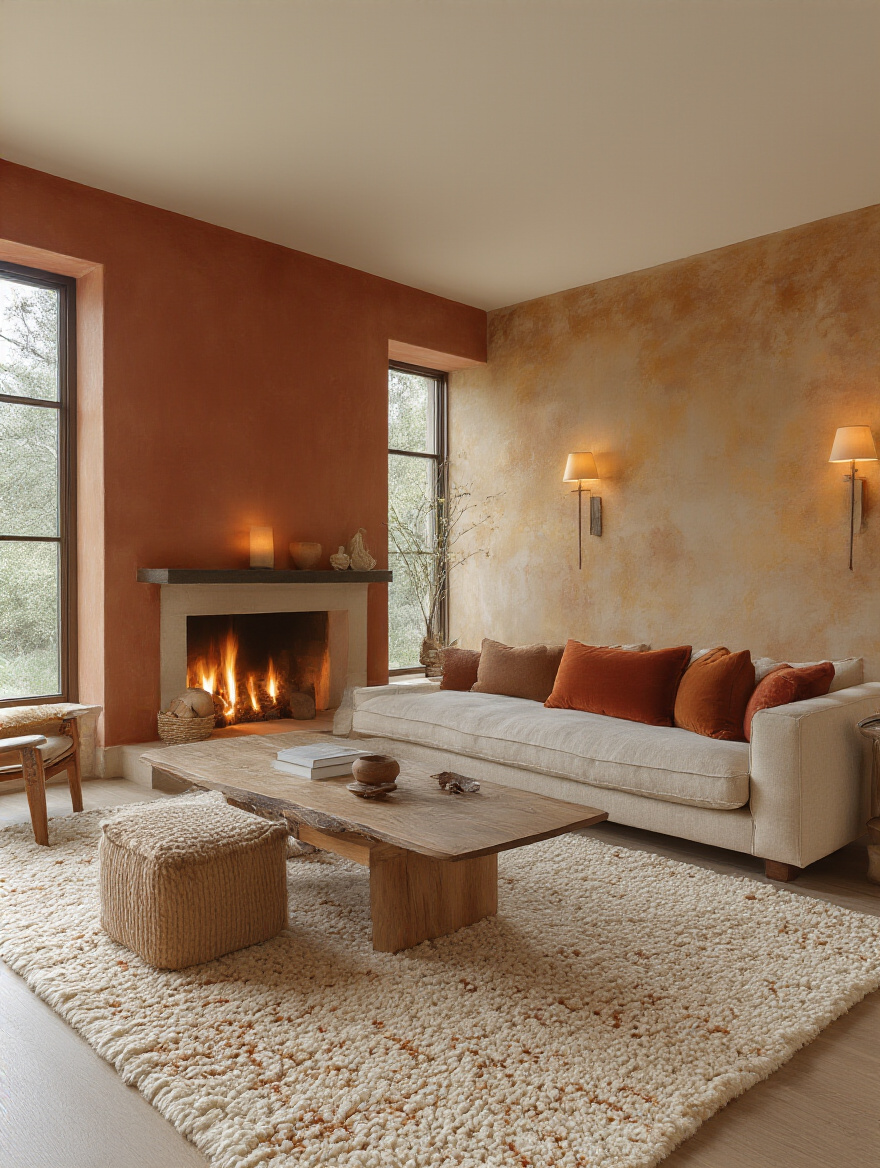
The BS everyone tells you is to just paint a single “accent wall.” I say, if you’re going for a true cocoon-like feeling, commit. Paint the whole room. If that’s too much, find a textured wallpaper with a warm, organic pattern. And always test your paint samples on the actual wall. Paint a big square and look at it in the morning, afternoon, and at night with the lights on. The way light hits it will completely change the color, and you want to be sure you love it in all its forms.
This is your chance to wrap the entire room in a visual blanket of warmth.
Implementing Core Elements for Physical Warmth (Part 2)
Okay, you’ve got the foundations covered—rugs, drapes, furniture, and color. The room is already feeling way better. Now it’s time for the advanced moves. This is about adding active sources of warmth and doubling down on efficiency. We’re talking about bringing in tech and making smart upgrades that provide a targeted, measurable boost in comfort.
10. Strategically Place Supplemental Heating Sources Like Electric Fireplaces or Radiant Heaters
Relying solely on your central heating is inefficient and often leaves you with cold spots. The shortcut? Zone heating. This is where supplemental heaters become your best friend. But I’m not talking about those ugly, glowing-orange things from your grandma’s basement. Modern electric fireplaces are a game-changer. They provide the visual focal point and hypnotic flicker of a real fire with zero mess and can be installed almost anywhere.
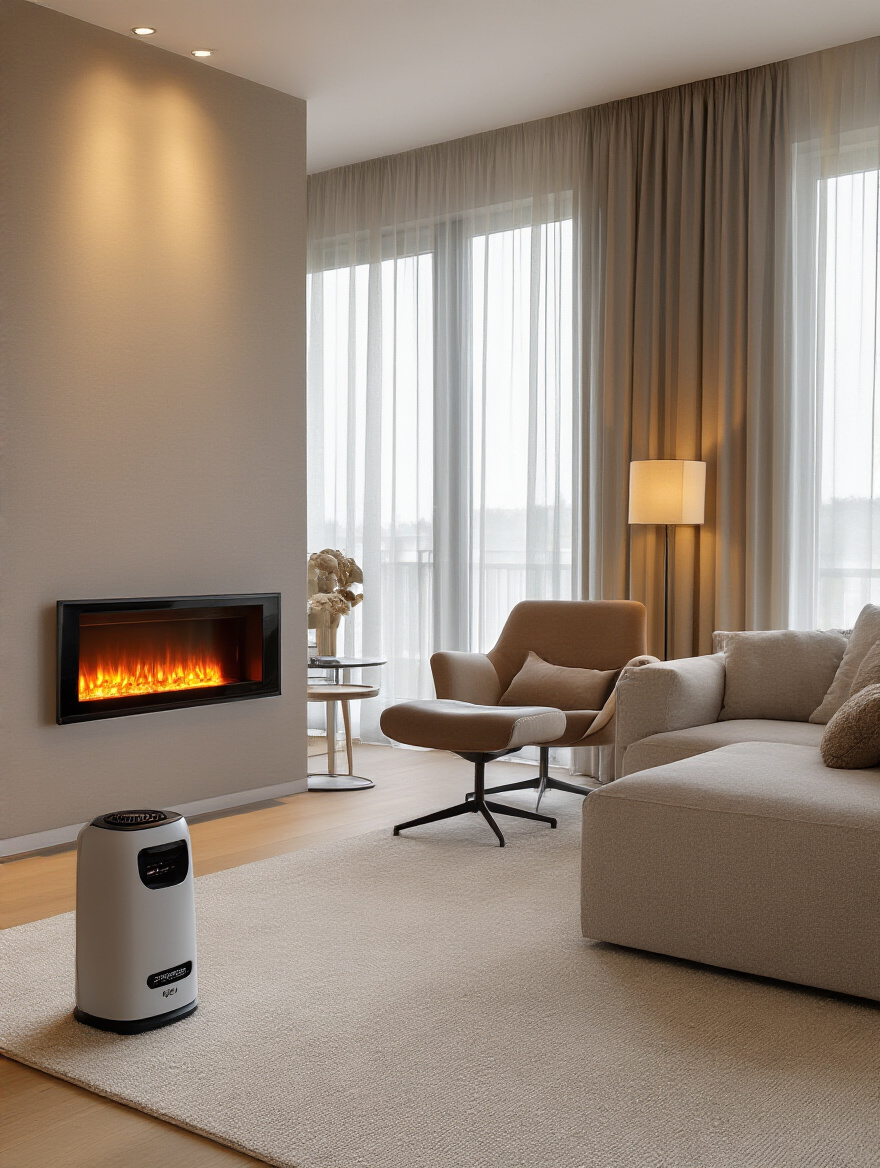
“An electric fireplace isn’t just a heater; it’s an anchor for a social space. People are instinctively drawn to a hearth. It becomes the heart of the room, perfect for mounting a TV above and creating a central gathering spot.”
Place one in your main seating area to create a warm, inviting core for your living room. For a drafty reading nook, a sleek, oscillating radiant heater can provide targeted warmth exactly where you need it. This allows you to keep your main thermostat a few degrees lower, saving money while making your most-used spaces feel incredibly toasty and inviting.
This tech is the perfect fusion of form and function, delivering both aesthetic and physical warmth.
11. Opt for Energy-Efficient Double or Triple Glazing on Windows to Significantly Reduce Heat Loss
I know this is a big one, but if you have old, single-pane windows, you are fighting a losing battle against the cold. They are thermal disasters. Upgrading to double or triple-glazed windows is one of the most significant long-term investments you can make in the comfort of your home. The space between the panes of glass is filled with an inert gas like argon, which is a terrible conductor of heat. That means it keeps the heat inside in the winter and outside in the summer.
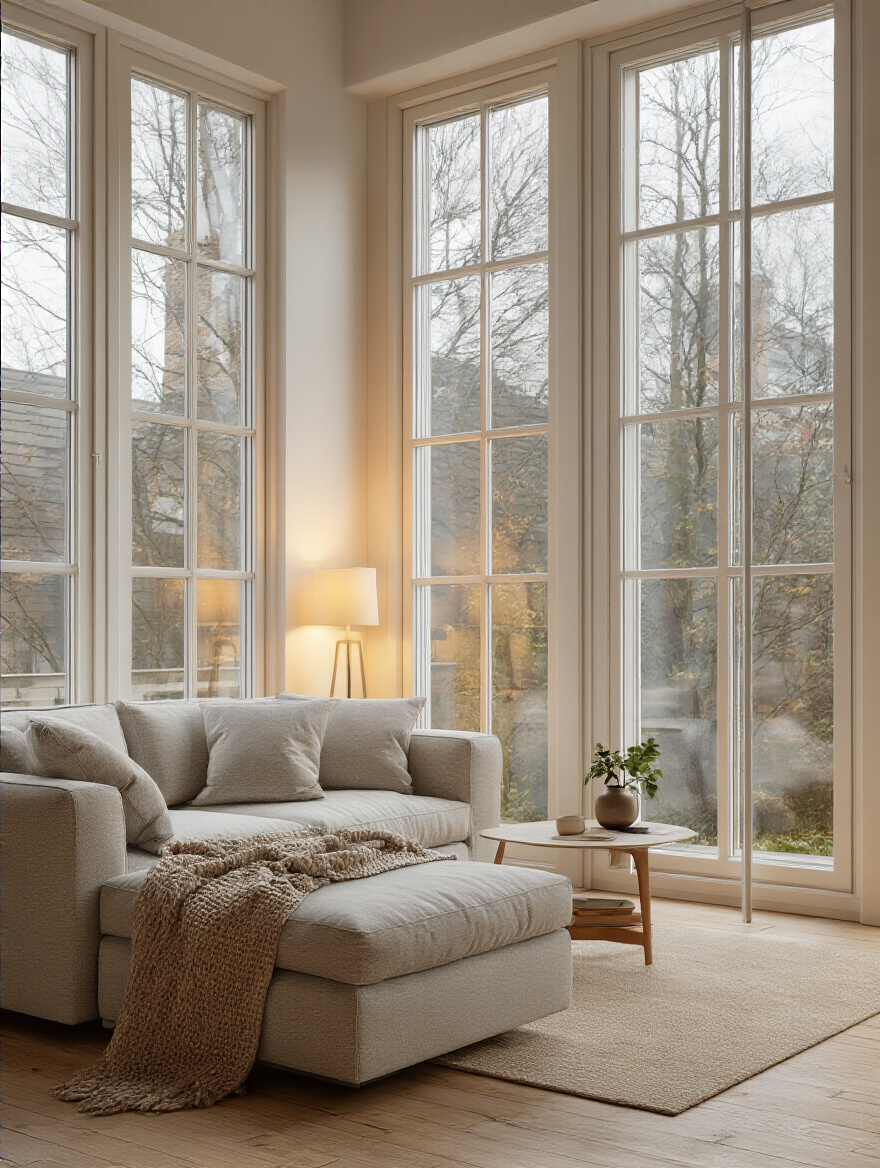
This isn’t just about saving money on your energy bills, though the savings are real. It’s about comfort. It eliminates the cold radiation you feel when you sit near an old window, making more of your living room usable and comfortable space. It also dramatically cuts down on outside noise, which contributes to a more serene and peaceful environment. It’s a huge upgrade, but its impact on creating a genuinely warm and quiet sanctuary is unmatched.
This is the heavy-duty solution for creating a truly sealed and consistently comfortable environment.
Styling and Enhancing the Cozy Ambiance (Part 1)
With the big-ticket items in place, we can finally get to the fun part: styling. This is where we layer in the personality and texture that takes a comfortable room and makes it uniquely yours. These are the elements that engage the senses, tell a story, and complete the transformation from a “room” into a “haven.” Think of it as adding the soul to the space.
12. Layer Abundant Textiles for Texture and Softness: Introduce Throws, Blankets, and Decorative Pillows
Okay, now we can talk about the blankets! But the key isn’t just having them; it’s about layering them with intention. You need a variety of textures. Mix a chunky knit throw with a soft faux fur one, and then add velvet or linen pillows. This visual and tactile variety is what makes a space look rich and feel inviting. It’s a sensory invitation to get comfortable.
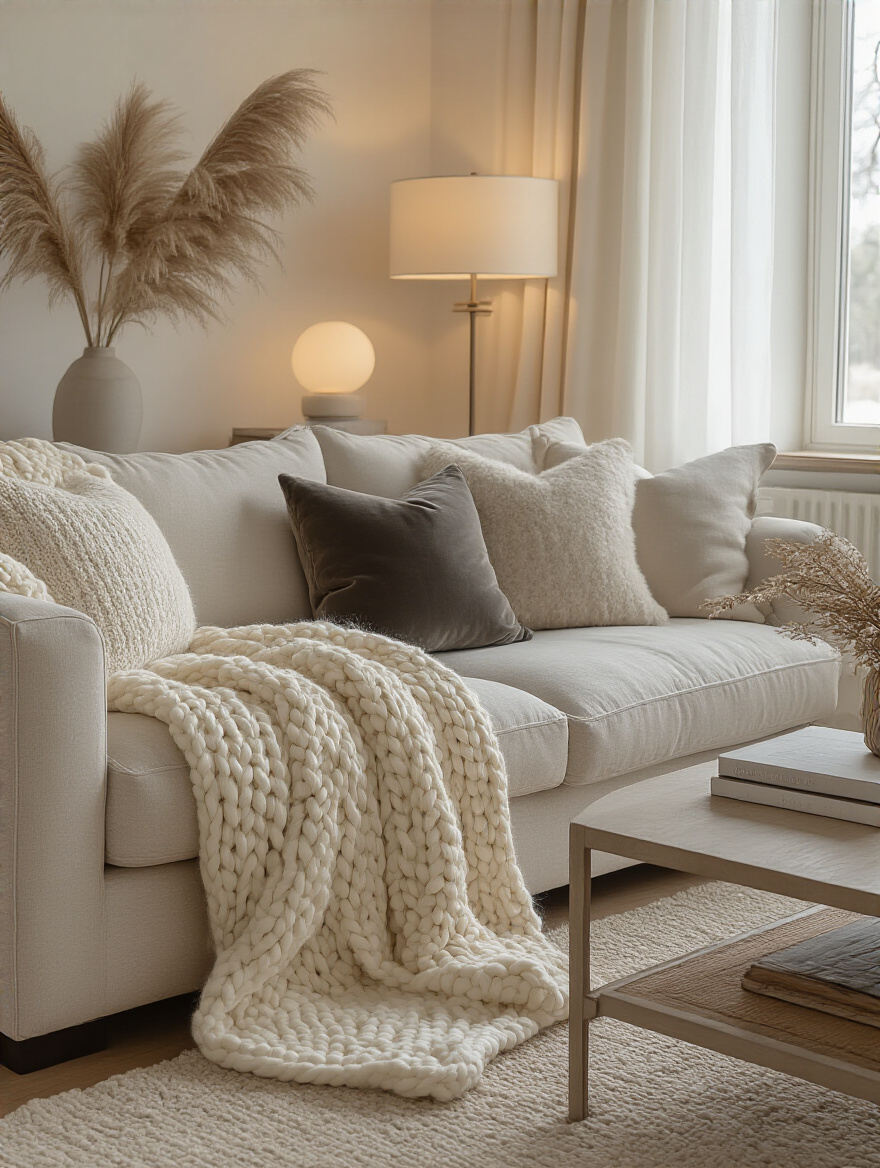
Don’t just fold a blanket neatly over the back of the sofa. Casually drape it over an arm or across a corner. Group pillows in odd numbers—threes or fives work best—and mix up the sizes and shapes. And please, have a big basket full of extra rolled-up blankets. When guests come over, it’s a non-verbal cue that says, “We want you to be comfortable, so grab a blanket and settle in.” It’s an act of hospitality that instantly puts people at ease.
These textile layers are the easiest and most effective way to dial up the immediate comfort factor.
13. Curate Soft, Ambient Lighting Sources: Replace Harsh Overhead Lights with Lamps and Dimmers
If you take only one piece of advice from me, let it be this: stop using your main overhead light. That single, bright light source—what I call the “Interrogation Lamp”—is the number one killer of cozy vibes. It casts harsh shadows and makes everyone look terrible. The solution is to create layers of light. You need multiple sources of softer light coming from different heights. That means floor lamps, table lamps, and accent lights.
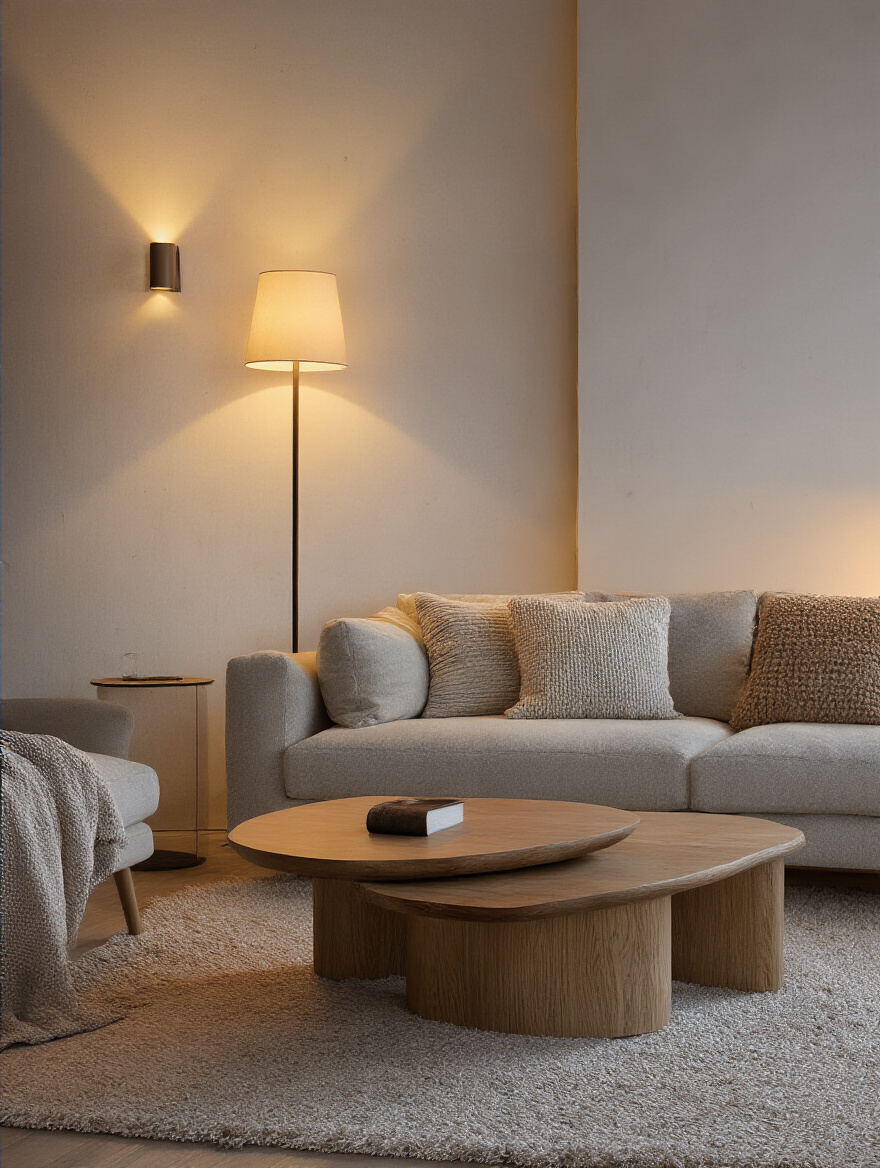
And here’s the real pro move: put everything on a dimmer. Everything. Dimmers are cheap, easy to install, and give you complete control over the mood of the room. For an even easier shortcut, use smart bulbs like Philips Hue. You can control the brightness and even the color temperature from your phone or with your voice. Being able to say, “Hey Google, set the living room to 30%” before a movie is pure magic. It’s the single most impactful, low-cost upgrade you can make to create a warm, social atmosphere.
Great lighting isn’t a detail; it’s the invisible architecture that defines the entire mood of your space.
14. Incorporate Natural Elements with Wood Accents and Indoor Plants for Organic Warmth
A room devoid of natural elements can feel sterile and artificial. Bringing in wood and plants is like opening a window and letting some life in. The grain of a wood coffee table, the texture of a wicker basket, the green leaves of a plant—these things connect us to the natural world on a subconscious level and have a proven calming effect. It’s called biophilic design, and it’s a powerful tool for creating a sense of organic warmth.

You don’t need to turn your living room into a jungle. Start with a few easy-to-care-for plants like a snake plant or a ZZ plant. Place them at different heights to draw the eye around the room. Introduce wood through small things first—picture frames, a serving tray, a decorative bowl. These touches break up the monotony of flat, manufactured surfaces and add a layer of texture and warmth that you can’t get any other way.
These organic elements are essential for making a space feel grounded, alive, and truly serene.
15. Display Personal Photos and Meaningful Decor to Infuse the Room with Sentimental Warmth
This is what turns a house into a home. A perfectly styled, impersonal room feels like a hotel lobby. A truly cozy room tells a story—your story. Frame those photos from your favorite vacation. Display that goofy piece of art your kid made. Put that weird little souvenir you bought on a trip on a shelf. These items are infused with memories and positive associations, and they radiate a sentimental warmth that no designer accessory can replicate.
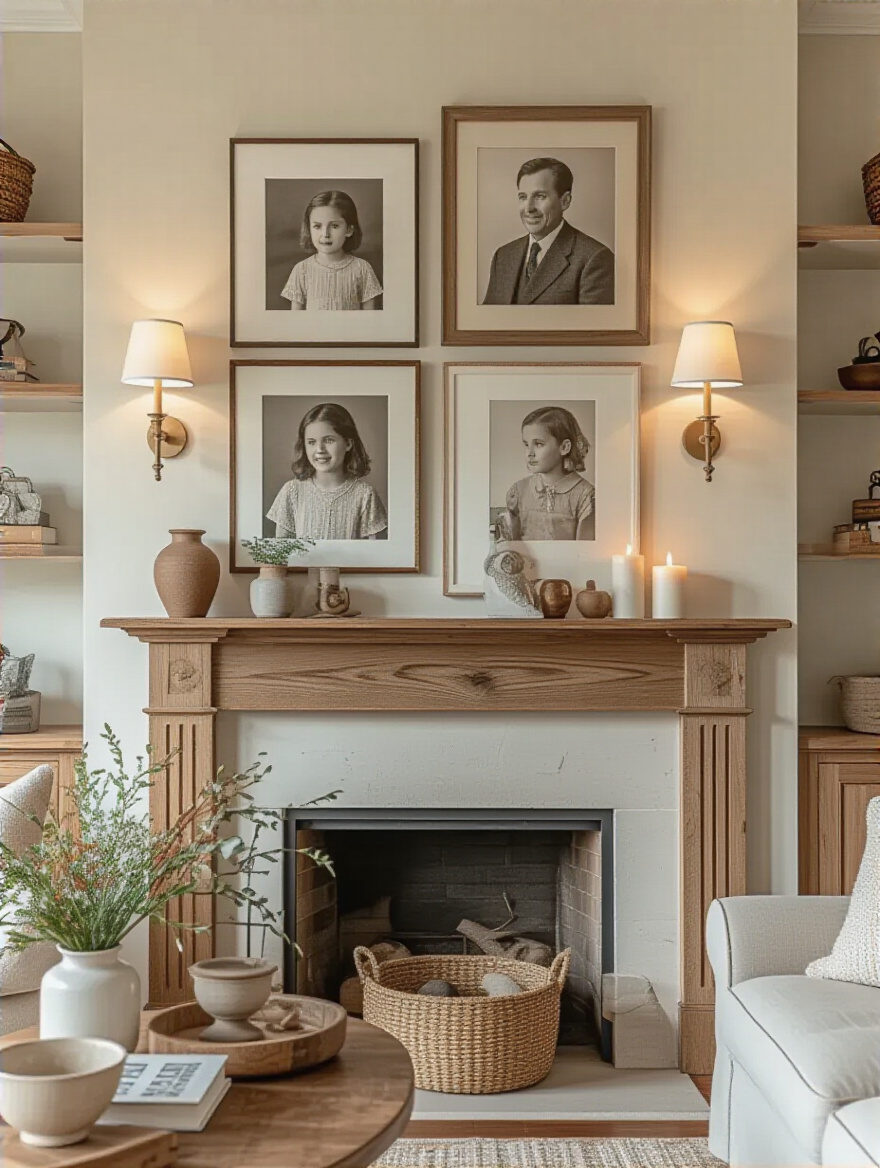
The trick is to curate them, not just scatter them everywhere. Create a gallery wall of your favorite photos. Dedicate one or two shelves to your most meaningful objects. This turns them into intentional focal points rather than clutter. When your friends come over, these items are conversation starters. They make your space feel authentic and lived-in, which is the very definition of a comfortable, welcoming environment.
Personal touches are the soul of the room, infusing it with a warmth that is uniquely yours.
Styling and Enhancing the Cozy Ambiance (Part 2)
We’re in the final stretch now. You’ve built the foundation and layered in the key elements. This final part is about refinement—the finishing touches that elevate the space and make it feel truly complete. This is where we polish the details and ensure every corner of the room contributes to the overall feeling of warmth and welcome.
16. Create Inviting Vignettes on Surfaces: Style Coffee Tables and Bookshelves with Curated Cozy Displays
A vignette is just a fancy design word for a small, curated grouping of objects. Instead of having a bunch of random things scattered across your coffee table, you group them with intention. The shortcut here is the “Rule of Three” and the power of the tray. Grouping items in odd numbers is just more visually appealing to the human eye. And placing those items on a decorative tray instantly makes them look like a cohesive, intentional display instead of clutter.
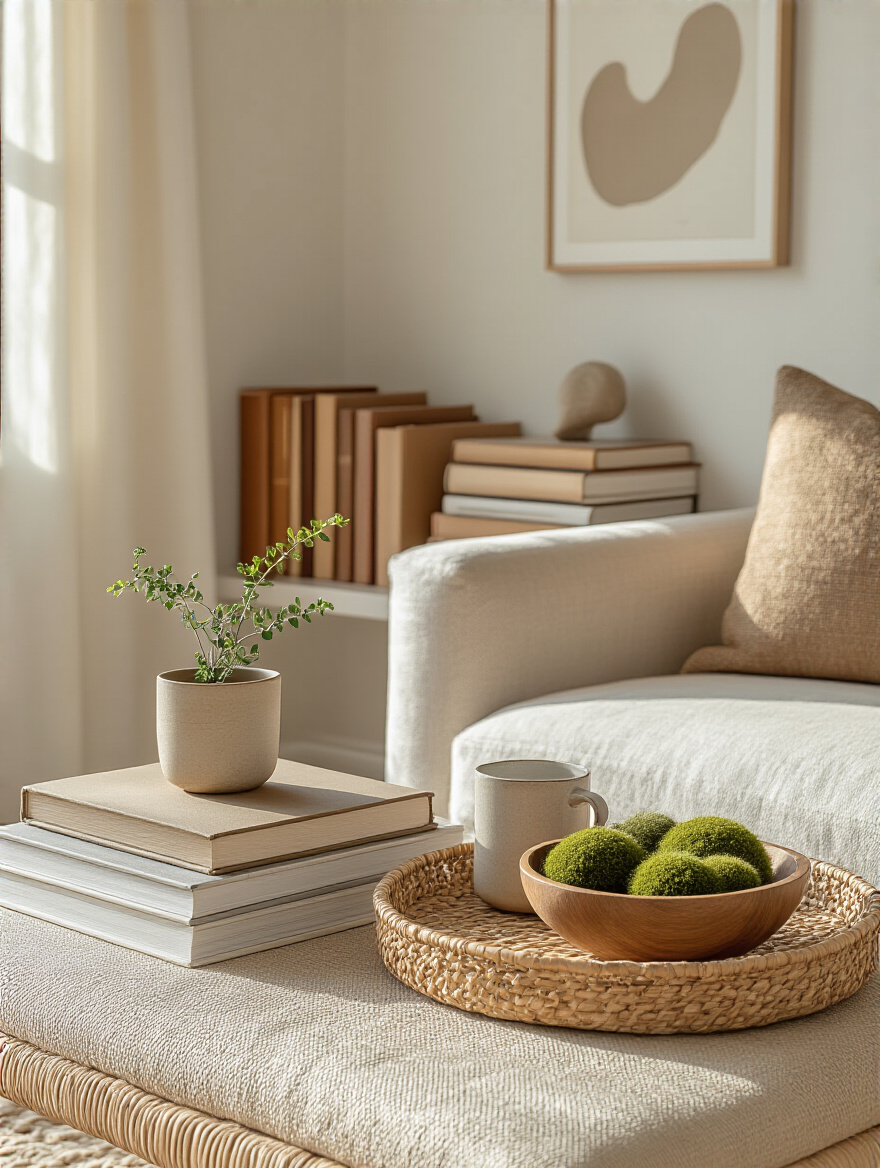
On your coffee table, try a stack of a few cool books, a small plant, and a candle on a tray. That’s it. On a bookshelf, break up the rows of books with a framed photo or a small sculptural object. These little “visual moments” give the eye a place to rest and make the room feel more thoughtful and put-together. It’s a simple technique that has a surprisingly sophisticated impact.
These curated displays turn your flat surfaces into points of interest and personality.
Advanced Comfort and Sustainable Warmth Optimization (Part 1)
Time to bring in the big guns. This section is about leveraging smart technology and unseen forces to create a level of comfort that’s automated, efficient, and consistent. This is how you take your cozy room and make it an intelligently managed environment that anticipates your needs and keeps the perfect vibe going with minimal effort.
17. Integrate Smart Thermostats for Consistent Comfort and Automated Temperature Control
A smart thermostat, like a Nest or Ecobee, is a non-negotiable piece of tech for a modern, comfortable home. Its biggest superpower is learning your routine. It knows when you’re home and when you’re away, and it adjusts the temperature automatically, so you’re never wasting energy heating an empty house. More importantly, it ensures your living room is perfectly warm the moment you walk in the door.
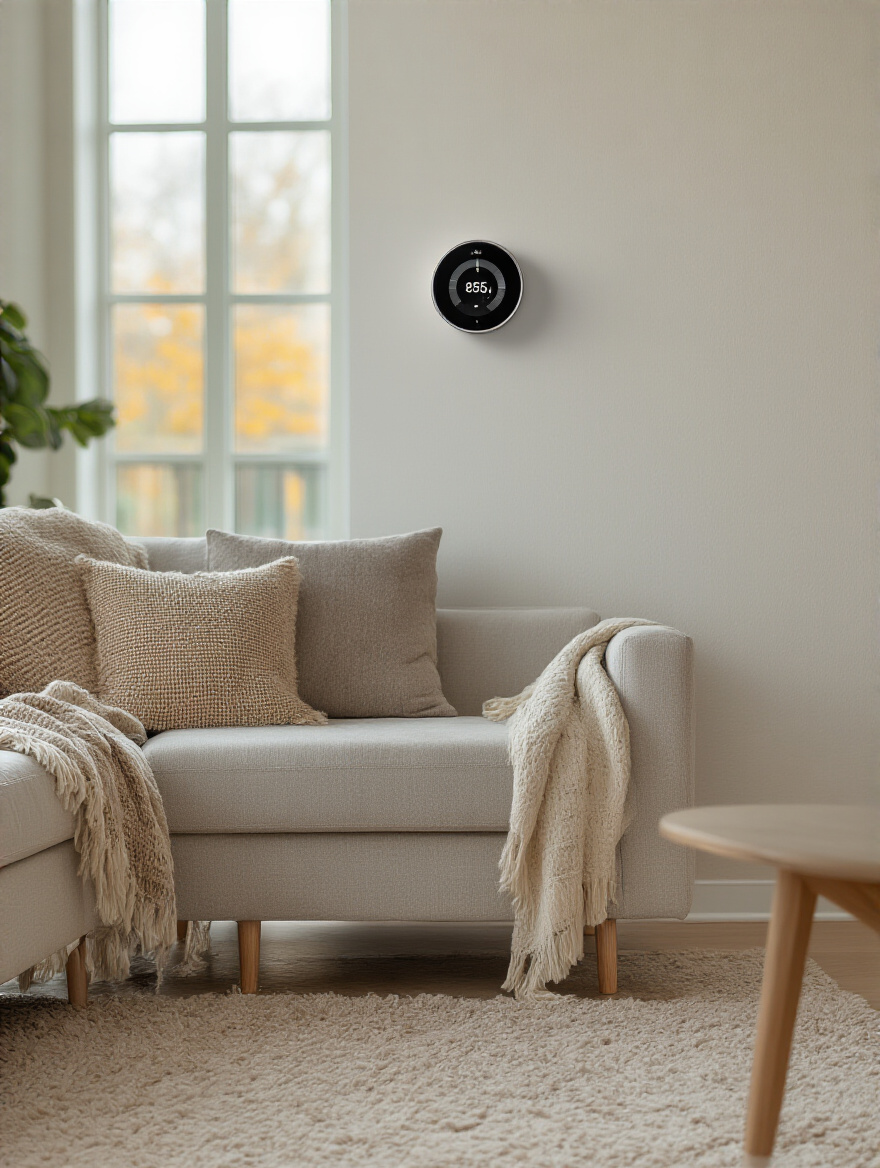
Even better, many of them integrate with remote sensors. You can put a small sensor in your living room, and the thermostat will prioritize keeping that room at your ideal temperature, not some hallway where the main unit is. It’s the ultimate set-it-and-forget-it solution for maintaining a consistently perfect level of warmth and comfort, all while saving you money. It’s the brains behind your brawny HVAC system.
This is how you automate your comfort and ensure your room is always ready for relaxation.
18. Burn Scented Candles or Use Diffusers for Olfactory Warmth and a Relaxing Aroma
Scent is the most underrated sense in interior design. You can have a room that looks perfect, but if it smells stale, the cozy illusion is shattered. Scent has a direct line to the parts of our brain that control memory and emotion. Using a signature scent for your home is a powerful way to create a feeling of warmth and welcome. Think warm, comforting scents like vanilla, sandalwood, amber, or cedar.
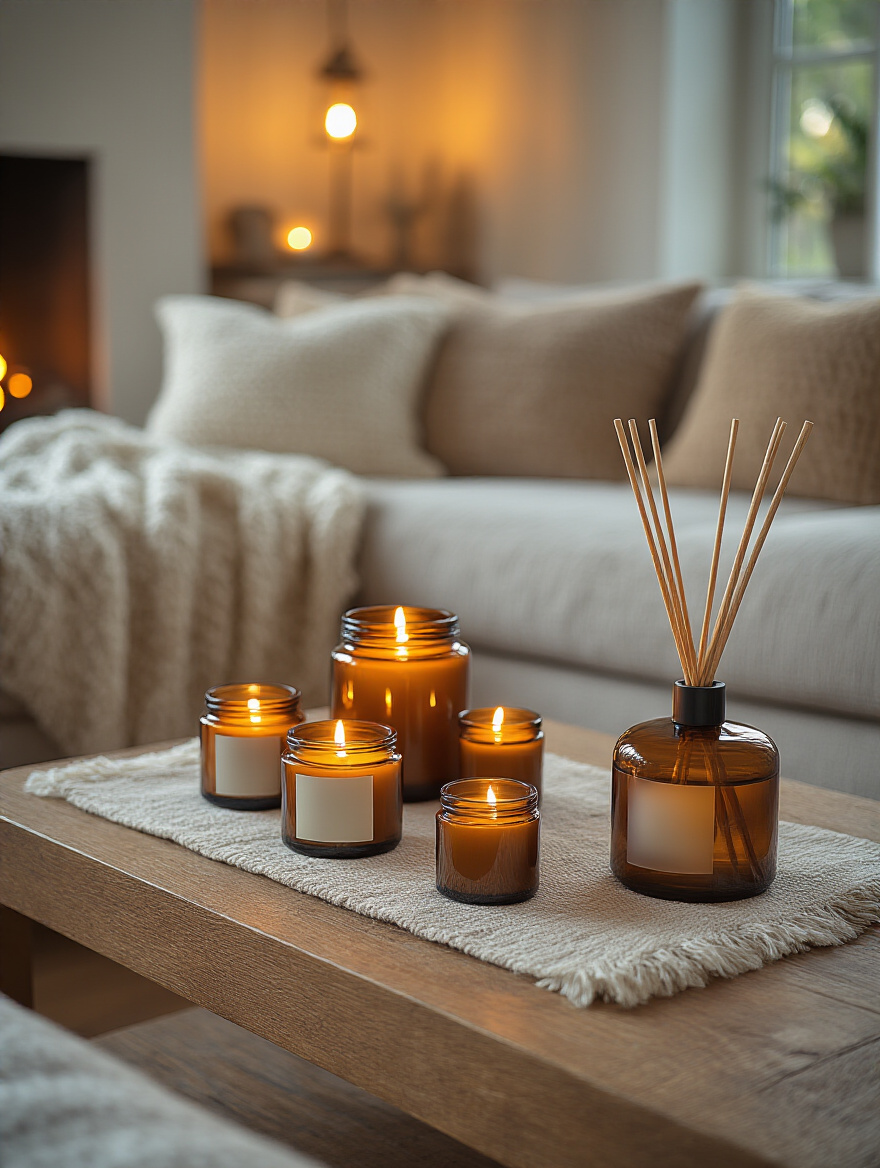
Candles provide that amazing flicker and glow, but for a constant, safer option, an essential oil diffuser is fantastic. You can even create your own custom blends. The key is subtlety. You don’t want to blast your guests with an overwhelming fragrance. You want a gentle, background aroma that makes people subconsciously relax and feel at ease the moment they walk in. It’s the final, invisible layer of your cozy atmosphere.
Engaging the sense of smell is the final frontier in crafting a truly immersive and comforting space.
19. Schedule Regular Professional HVAC Maintenance to Ensure Your Heating System Runs Efficiently
This is probably the most boring tip on the list, but it’s one of the most critical. You can do everything else right, but if your heating system is inefficient or on the fritz, you’ll never achieve consistent warmth. An annual tune-up by a professional is like a check-up for your home’s heart and lungs. They’ll clean the components, check for issues, and make sure it’s running at peak efficiency.

An efficient system delivers more consistent heat, costs less to run, and is far less likely to break down in the middle of a cold snap—which is exactly when you and your guests need it most. Think of it as preventative care for your comfort. It’s a small annual investment that pays huge dividends in reliability and peace of mind all winter long.
A healthy HVAC system is the invisible, hardworking hero of your warm and cozy living room.
20. Minimize Clutter to Maximize Visual Tranquility and Promote a Serene, Welcoming Atmosphere
You cannot have a cozy room that is also a cluttered room. It’s impossible. Clutter is visual noise, and it constantly sends signals to your brain that there are tasks left undone. It creates a low-key level of stress that actively works against the calm, relaxing atmosphere you’re trying to build. A serene space is one where your eye can rest.

This doesn’t mean you have to become a minimalist. It just means everything needs a home. Use decorative baskets to wrangle blankets and remote controls. Invest in a media console that hides your game consoles and all those ugly wires. I’m a huge A/V guy, but nothing ruins a vibe faster than a visible tangle of cables. A clean, organized space feels bigger, brighter, and infinitely more peaceful.
Decluttering is a free, instant upgrade that brings immediate calm and tranquility to your space.
Advanced Comfort and Sustainable Warmth Optimization (Part 2)
We’ve optimized, we’ve styled, and we’ve decluttered. The final step is learning how to keep the vibe fresh. A truly great space isn’t static; it evolves with you and with the seasons. This final tip is the secret to long-term success, ensuring your living room always feels current, intentional, and perfectly attuned to the time of year.
21. Rotate Seasonal Decor and Textiles to Maintain a Fresh Sense of Coziness Year-Round
The fastest way to get bored with your room is to leave it exactly the same all year. Rotating your textiles and a few key decor pieces is the secret weapon against decor fatigue. In the fall and winter, bring out the heavy hitters: chunky wool blankets, velvet and faux fur pillows, and deeper, warmer color accents. The room should feel like it’s giving you a big, warm hug.
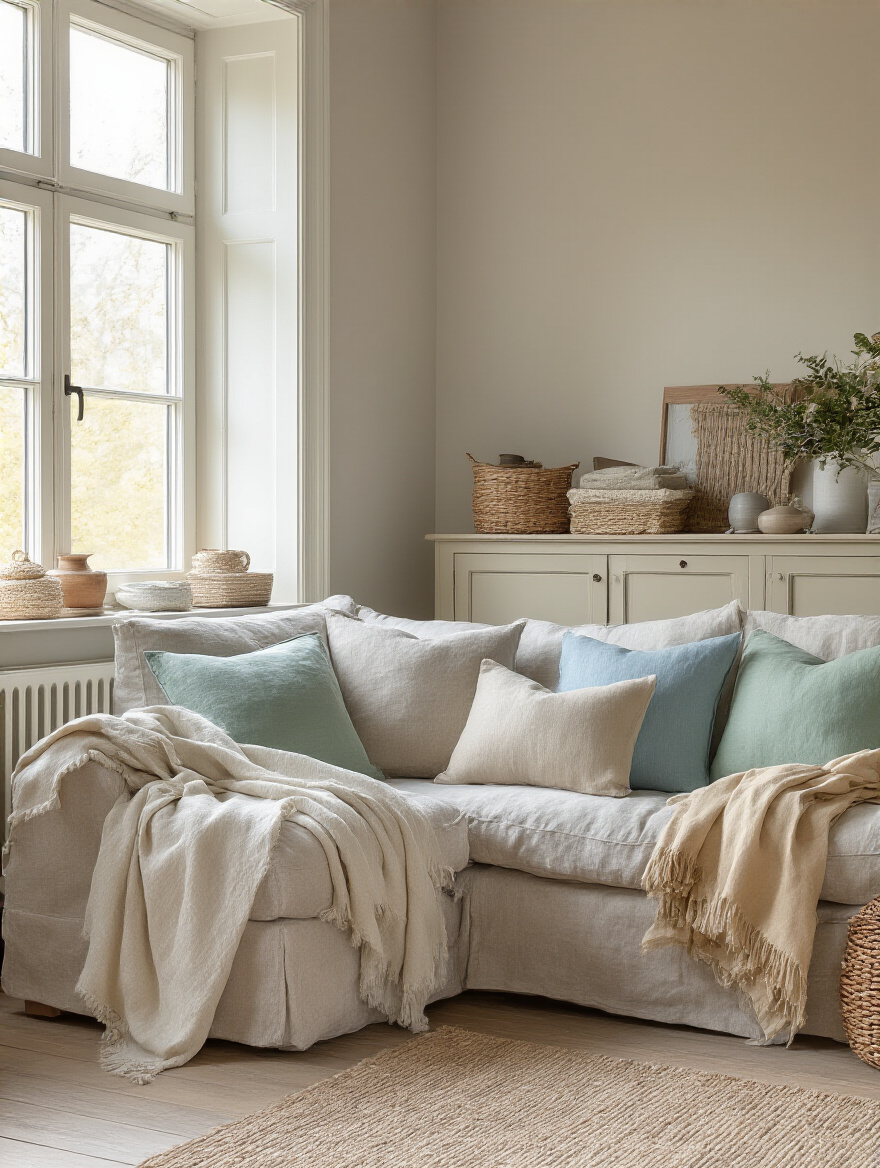
Then, when spring rolls around, pack those away and bring out lighter fabrics like linen and cotton. Swap the dark pillow covers for brighter, airier ones. Switch out a heavy rug for a natural fiber one like jute. This simple seasonal swap completely refreshes the energy of the room. It makes you appreciate your cozy winter things more when you bring them back out, and it keeps your space feeling dynamic and in tune with the world outside.
This simple ritual ensures your living room always feels fresh, inviting, and perfectly cozy for the season.
Conclusion
So there you have it. The real playbook. Creating a cozy, warm living room isn’t about one magic bullet; it’s about layering all these ideas together. It’s about making your space work smarter, not harder—from sealing drafts and optimizing light to using smart tech and personal touches to build an atmosphere. It’s about designing a space that makes people feel something—relaxed, welcome, and happy. A space that pulls people in and encourages them to stay, connect, and make memories.
Don’t get overwhelmed and try to do it all at once. Pick one thing that resonated with you. Maybe it’s finally dealing with that interrogation light, or maybe it’s just getting a great rug. Start there. Every small change builds on the next, and before you know it, you’ll have created a space that isn’t just nice to look at, but is the true, warm, beating heart of your home. The kind of place your friends love to be, and you love to come home to.
